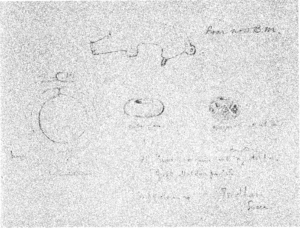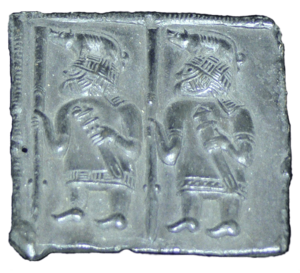Guilden Morden boar facts for kids
Quick facts for kids Guilden Morden boar |
|
|---|---|

1904 drawing of the Guilden Morden boar
|
|
 |
|
| Material | Bronze |
| Size | 2.5 in × 1 in (6.4 cm × 2.5 cm) |
| Created | c. 500–700 AD |
| Discovered | 1864 or 1865 Guilden Morden, England |
| Discovered by | Herbert Fordham |
| Present location | British Museum |
| Registration | 1904,1010.1 |
The Guilden Morden boar is a small metal figure of a boar. It was made by the Anglo-Saxon people around 500 to 700 AD. This ancient object might have been a decoration on top of a helmet.
It was discovered in a grave around 1864 or 1865. The grave was in Guilden Morden, a village in Cambridgeshire, England. The boar was found with a skeleton and other items, like a small bead. Today, only the boar remains. Herbert George Fordham, whose father found the boar, gave it to the British Museum in 1904. You can see it there in room 41.
The boar has a simple design. Its most noticeable feature is a large mane. Eyes, eyebrows, nostrils, and tusks are only faintly visible. The way its legs are shaped suggests it was attached to something else. This could have been a helmet, similar to how boars are shown on helmets in old Swedish artwork called the Torslunda plates.
Boar-crested helmets were very important to the Anglo-Saxons. They were part of an old Germanic belief. People thought the boar would protect them. The Guilden Morden boar is one of only three such boar figures known to still exist. The others are from the Benty Grange and Wollaston helmets. The Guilden Morden boar has been shown in museums both in England and other countries. The famous Anglo-Saxon poem Beowulf even mentions helmets with boar decorations five times. This shows how common and important they once were.
What is the Boar?
The Guilden Morden boar is well-preserved and has a simple design. It is made from bronze or a similar copper metal. The figure is about 2.5 inches (6.4 cm) long. Its most striking feature is a prominent mane.
You can faintly see an eye, eyebrows, and nostrils. These details might have been added after the boar was cast. A tusk is shown on the boar's right side. The tail used to form a full circle, but it broke off around 1904.
The boar's front and back legs were each cast as one piece. The front legs have a hollow space, like a socket, about 3.5 mm deep. The back legs have a pin that sticks out about 6 mm. This pin-and-socket design allowed the boar to be attached to another object. It was most likely fixed onto a helmet.
How Was It Found?
The boar was discovered around 1864 or 1865. It was found in Guilden Morden, a village in Cambridgeshire. This village is about 16 miles (26 km) southwest of Cambridge. It is also about 5 miles (8 km) west of Royston.
Herbert Fordham found the boar while digging for coprolites. Coprolites were fossilized animal waste, rich in phosphate. They were used as fertilizer back then. Digging for coprolites was one of the main jobs in Cambridgeshire, besides farming.
In 1904, Herbert George Fordham, Herbert's son, wrote about the discovery. He said the boar was found in the ground, not very deep. It was with other items, including a small bead with a pattern. All these objects were in a grave with human bones. It seemed like the items were originally worn around the neck of the buried person.
A drawing from 1882–1883 shows the boar with a bronze ring and two glass beads. One bead was amber-colored, and the other was red with white patterns. The drawing notes that these items were "all found in a grave with a doubled-up skeleton." Fordham had no more information about the discovery. He gave the boar to the British Museum in 1904.
Why Boars on Helmets?
The Guilden Morden boar is an Anglo-Saxon artifact. This is known because of the other items found in its grave. Also, similar helmets have been found in England. For a long time, people thought it was Celtic, but in 1977, it was correctly identified.
It was probably placed on top of a boar-crested helmet. Many such helmets have been found or seen in old drawings. Only two other boar-crested helmets are known to exist today. These are from Benty Grange and Wollaston. The Guilden Morden boar looks very similar to the boar on the Benty Grange helmet.
The Benty Grange boar has a similar shape and a long, pointed snout. Its front and back legs are also joined as one piece. The Benty Grange helmet dates to about 650 to 700 AD. The Wollaston helmet is from around 675 AD. The Guilden Morden boar is generally dated to the sixth or seventh century AD.
The boar would have decorated an early type of "crested helmet." These helmets were common in Northern Europe from the 500s to the 1000s AD. Remains of about fifty such helmets are known. Most are from Scandinavia. Only five Anglo-Saxon helmets are well-preserved enough to show their original shape. These include helmets from Benty Grange, Sutton Hoo, Coppergate, Wollaston, and Staffordshire. The helmet the Guilden Morden boar was on might have looked similar to these.
Boar crests are also seen on Scandinavian helmets in old art. For example, one of the four Torslunda plates from Sweden shows warriors with boar-crested helmets. The boars on these helmets look very much like the Guilden Morden boar. They also seem to be attached using a pin and socket, just like the Guilden Morden boar.
Where Can You See It Today?
The Guilden Morden boar is on display at the British Museum in London. It is in Room 41. This gallery shows objects from Europe between 300 and 1100 AD. Other famous items there include finds from the Sutton Hoo ship-burial and the Lycurgus Cup.
Besides its permanent home, the Guilden Morden boar has traveled for exhibitions. From April to October 2004, it was shown at the Sutton Hoo Visitor Centre in Suffolk. This exhibition was called Between Myth and Reality. It was also displayed in Germany from July to October 2013. This was at the Diözesanmuseum Paderborn in Paderborn, as part of an exhibition about the Christianization of Medieval Europe.



